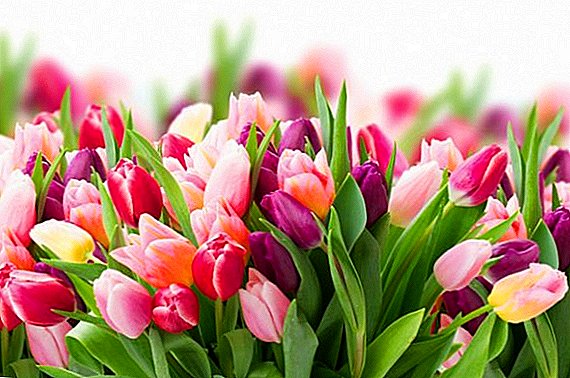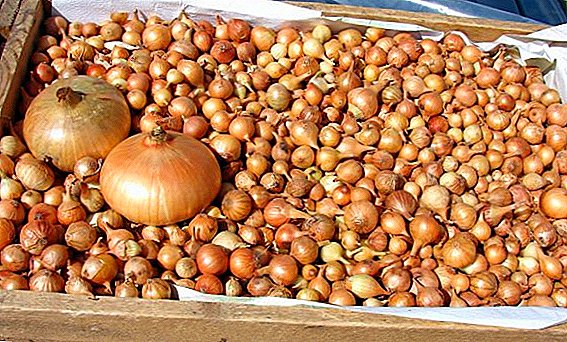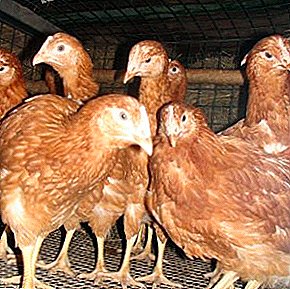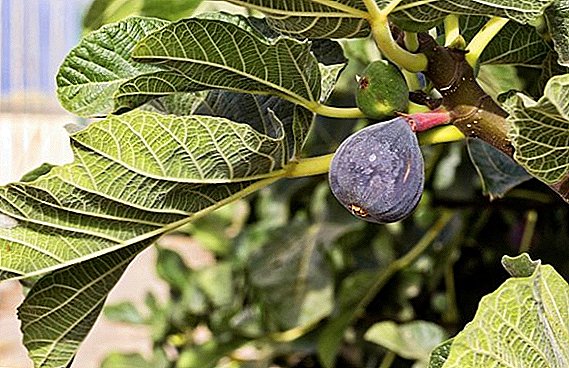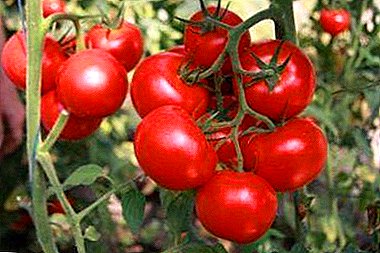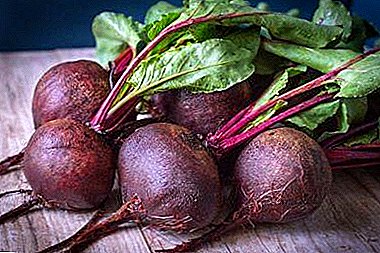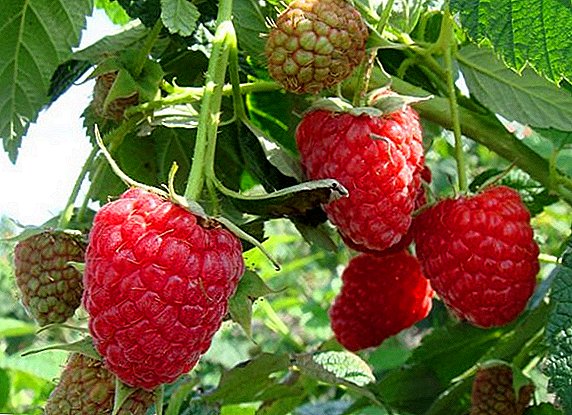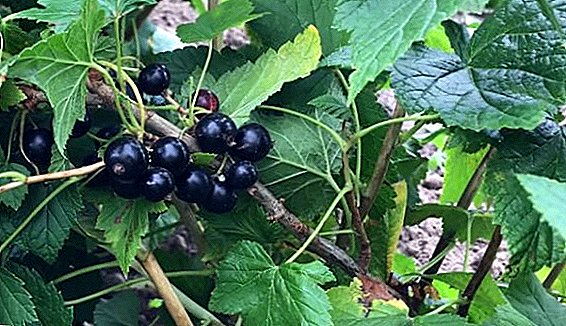 Before laying a currant in the dacha, the gardener makes a choice among dozens of varieties. In this case, the choice is made in favor of winter-hardy, productive and resistant to pests and diseases. Almost 20 years ago, breeders obtained a new variety of currants, which has all these qualities. The creators gave the brand the name "Pygmy".
Before laying a currant in the dacha, the gardener makes a choice among dozens of varieties. In this case, the choice is made in favor of winter-hardy, productive and resistant to pests and diseases. Almost 20 years ago, breeders obtained a new variety of currants, which has all these qualities. The creators gave the brand the name "Pygmy".
Selection
The variety of black currant "Pygmy" was obtained as a result of directed selection in 1999, by crossing two currant varieties: "Bredthorp" and "Seedling of the Dove". Breeding work was carried out by the employee of the South Ural Research Institute Ilyin BS
Did you know? Gardeners claim that sound vibrations (music, voice) can affect plant growth. There is an opinion that calm beautiful music contributes to the growth and flowering of plants, and sharp sounds in the style of heavy metal - they are oppressed and suspended in growth.
Description and characteristics
"Pygmy" - middle-ripe variety, with medium-sized and large berries and not too voluminous shrubs.
Shrub
Black currant bushes "Pygmy" do not take up too much space in the garden, as the bush is not spreading. It is not too thick with lateral branches, the height of an adult plant reaches 1.5-2 m. Young, not lignified branches of this variety have a pinkish color of shoots. Leaves "Pygmy" powerful, large, strongly corrugated, bright green. The upper part of the sheet plate is shiny. The buds are located on the branches in staggered order relative to each other. Blossoms "Pygmy" imperceptible, pale buds with tiny flowers. On the berry tassels of this variety is from 5 to 12 berries. 
Berries
The berries of this variety are medium and large, located on a green long stalk. The mass of berries from 2.5 to 7.5 g. The color of the fruit is black, brilliant. Taste is sweet, juicy berry. The skin is dense, not prone to cracking. The berries have a pronounced currant flavor.
Did you know? In unripe currants 4 times more vitamin C than in ripe.
Some features of the variety
"Pygmy" has good resistance to diseases and insect pests, but still requires some care and attention to the gardener. Currants need time to protect against disease with the help of special treatments and properly form.
Disease and Pest Resistance
Kidney mite
- This pest lives in the kidneys of currants, its presence causes swelling and further death of the kidneys.
- You can fight this pest with the help of the treatment of infected bushes in late February or early March.
- Processing needs to be carried out still on snow, but before blooming of kidneys.
- For treatment, you can use drugs such as "Nitrafen" (300 g of the drug per 10 liters of water) or colloidal sulfur (100 g per 10 liters of water).
- Before spraying, you need to manually tear off tick-borne kidneys, they can be easily distinguished from healthy buds in terms of volume - they are usually twice as large as healthy ones. If there are too many infected buds on a branch, then such a branch is separated from the bush with the help of a garden pruner and taken out of the garden area.
 Aphid
Aphid
- A small pest settles on the leaves and young shoots, feeds on plant sap, which weakens and dries currants.
- It is necessary to start a preventive fight against aphids even before the buds are dissolved. To do this, carry out early spring processing of the berry with a solution of "Karbofos" (30 g of the drug per 10 liters of water) or liquid potassium soap (30 g of soap per 1 l of water).
- In the process of vegetation, traps of yellow color are placed under the currant bushes, with a solution of soap and water poured into them. Not bad, they also recommended themselves as a repeller for aphids laid out on the ground under the bushes sheets of food or technical foil. Its brilliance scares the females of these insects.
- Strongly affected by aphids branches are cut and destroyed with the help of fire.
 Mealy dew
Mealy dew
- This is a fungal disease, with it on a diseased plant young shoots, fruits and leaves are covered with white bloom.
- It is difficult to cure a diseased plant, therefore regular preventive treatments are needed.
- The first treatment is carried out in early March (before bud break) with the help of the drug "Nitrafen". Diluting the drug with water, it is necessary to strictly follow the proportions indicated in the abstract.
- A week later (in mid-March), a secondary treatment is carried out with a soap-soda solution (40 g of soda + 40 g of laundry soap per 10 liters of water).
- Soap-soda sprays are repeated during the summer: immediately after flowering and twice more with an interval of 14 days.
 Anthracnose and septoriosis
Anthracnose and septoriosis
- This is also a fungal disease: spores of fungus-pathogens, getting into a suitable environment, begin to actively develop and infect nearby branches, leaves and neighboring plants.
- Anthracnose appears as a placer of small dark brown specks, up to 1 mm in diameter, located on the leaves. Over time, the leaflet is swollen with tubercles in places where anthracnose spots appeared.
- Septoriosis causes currant to appear on the leaf blades of round or angular spots (up to 3 mm), initially the spots appear brown, slightly later their middle area brightens, and a burgundy border appears on the edge of the spot.
- To combat these diseases can only be through prevention.
- In order to prevent the disease, in the middle of May (before flowering) the bushes are treated with a one percent solution of copper sulfate or Bordeaux mixture.
- In autumn, under fallen bushes, all the fallen leaves are collected and burned (or removed outside the site). This is done so that the fungus does not overwinter in plant debris.
 Currant Terry
Currant Terry
- This is a viral disease: infected bushes change the color of flowers from pale white to pale lilac, the petals of round flowers become elongated and look like terry from a distance.
- On infected peduncles, almost half of the flowers fall off, never forming an ovary. In the process of growth, few of the ensuing berries take on an ugly shape and grow into small ones.
- In order to prevent the currants from curling in early spring, the bushes are sprayed with a solution of water and the Nitrafen preparation (50 g of the substance per 5 liters of water).
- An aqueous solution of colloidal sulfur (50 g of the substance per 5 l of water) is also suitable for the prevention of terry.
- Already diseased bushes are dug up with roots and removed outside the garden, after which it is desirable to burn them.
 One of the valuable characteristics of currant "Pygmy" is its high resistance to fungal diseases (anthracnose, powdery mildew), but the gardener is still worth the preventive treatment of the bushes.
One of the valuable characteristics of currant "Pygmy" is its high resistance to fungal diseases (anthracnose, powdery mildew), but the gardener is still worth the preventive treatment of the bushes.
Important! Garden treatment with chemicals should be carried out before flowering plants, otherwise, along with insects that cause damage to the garden, it is possible to destroy beneficial insects. After flowering, only biological treatments (solutions of garlic, mustard and pepper) are allowed.
Garlic extract for processing currant bushes
Ingredients:
- 300 g of garlic;
- 2 liters of water.
How to cook:
- Garlic is divided into slices, peeled from the skin and ground in a meat grinder or in a blender to the state of a homogeneous slurry.
- A container having a volume of at least 3 liters is taken, and a tight-fitting lid.
- 2 liters of water are poured into the container and brought to a boil.
- Milled garlic is added to boiled water, mixed and removed from heat.
- A saucepan with a future garlic tincture tightly covered with a lid and left to insist for 14 days.
- After 2 weeks, a concentrated garlic tincture is ready for use.
 How to apply:
How to apply:
- Matured garlic concentrate is diluted in 10 liters of water.
- For spraying currants take a half-liter jar of already diluted infusion and add water to the bucket (10 l).
- Garlic processing for currants can be carried out every two weeks - it is absolutely harmless to people and insects and protects berry bushes from diseases and pests.
Did you know? One teaspoon of soil contains more microorganisms than people currently live on our planet.
Currant pests that hibernate under the bark and in the kidneys can be controlled with "boiling soul":
- To do this, choose a time when there is still snow in the garden, but spring is not far off (middle or end of February, the first decade of March).
- To treat one bush boil 10 liters of water.
- The boiled water is poured into a garden metal watering can and quickly (until the water has cooled) pour boiling water over the currant branches.
- This is a very effective method, long proven and well-established among gardeners. If you hold this event on time, subsequent chemical and biological treatments from the kidney tick may not be necessary.
Video: spring processing of currants with boiling water
Drought resistance and frost resistance
This variety for almost two decades of testing in the gardens of Russia showed excellent frost resistance. The plant endures frost free down to -20 ° C. Currant "Pygmy" well endures long periods without watering, sometimes it is enough rain. Additional watering is usually required by the plant in dry years.
Ripening period and yield
"Pygmy" is mid-season variety, the first berry brushes begin to ripen by the end of the first decade of July. Fruiting usually lasts 30-35 days. This variety is fruitful: 3 to 5 kg of berries are harvested from one adult bush. "Pygmy" does not need growing near varieties of pollinators, as it is a self-fertile variety. It is this quality that is the key to high annual yield.
Read also about the benefits and secrets of growing black currant varieties "Exotica", "Dachnitsa", "Vydrenaya".
Transportability
At low positive temperatures (from +13 to +15 ° C), the harvest can be store for a month. Transportability in currant "Pygmy" is not bad - dense, not bursting skin allows transporting berries in long-distance tracts in specialized trays. 
Using
Black currant berries of this variety are eaten fresh, and also used in compotes, jelly, jams, jams and confiture, as a filling for pies and dumplings, they are also frozen and dried.
Did you know? One glass of black currant contains so much vitamin C that this amount three times overlaps the daily rate needed by an adult.
How to choose seedlings when buying
Laying the berries, the gardener needs saplings of good varieties. The most reasonable way is not to buy seedlings on the market from random sellers, but to give preference specialized nurseries and well-established private breeders. Specialized farms will provide complete information about the characteristics of the plant, about how to care for it, as well as show photos of berries, bushes and leaves. It is necessary to buy seedlings in early spring (even before blooming of buds on currants) or in autumn: in October and early November.  What to look for when buying blackcurrant saplings:
What to look for when buying blackcurrant saplings:
- Seedlings should be annuals, their height should be no higher than half a meter.
- The bark on the seedlings must be uniform and free from damage.
- Young bushes should not be blooming leaves.
- Special attention should be paid to the root system: the roots must be elastic, strong and not weather-beaten.
- When transporting over long distances, the root system of purchased seedlings is wrapped in a damp cloth. A polyethylene film is on top of the fabric, in the second layer, this will prevent the moisture from evaporating from the fabric, which means that the roots will remain wet until they arrive at the landing site.
- If, however, the roots on the sapling have dried up (regardless of the reasons), the gardener should lower the plant into the water and leave it in that position for two or three days. Drinking moisture, currant root system will restore the turgor and will be suitable for planting in open ground.
Important! The root system of a healthy, viable black currant seedling has a volume and length of 20-25 cm.
Choosing a place
For planting currant "Pygmy" is best suited not shaded, well shined during the day. Currant rows are preferably located from south to west, this location will provide the best coverage of plants during the day. The place where the berries will grow should be protected from the cold northern winds by a wall or fence. This will not allow returnable frosts to destroy the currant color, which means - the next harvest.  The soil should not be swamped, so lowland is not very suitable for this, it is better to choose a flat area or located on the hill. Black currant also does not like close to the groundwater, as it is prone to decay of the root system. The soil should not be acidified.This berry loves slightly acidic soil. It is on such soils that the berries get the right amount of sugar.
The soil should not be swamped, so lowland is not very suitable for this, it is better to choose a flat area or located on the hill. Black currant also does not like close to the groundwater, as it is prone to decay of the root system. The soil should not be acidified.This berry loves slightly acidic soil. It is on such soils that the berries get the right amount of sugar.
Learn more about the soil: basic properties and composition, types, value of acidity, methods of primary treatment.
Time and landing scheme
When and how to plant
- It must be remembered that currant is a cross-pollinated crop. Despite the fact that the variety "Pygmy" is self-fertile - it will be able to show the highest yields only when repilating with currant bushes growing nearby. Therefore, it is advisable to plant the plant in group plantings (2-5 currant bushes).
- If the planting of berry bushes occurs in early spring (before bud break), the air temperature by this time should be from +5 to +10 ° C, the soil should be dried. Autumn berry laying is carried out throughout October and the first decade of November (weather permitting).
 Planting currants:
Planting currants:
- After selecting the location of the future berry, the gardener conducts preliminary preparation before planting: digging planting pits 30–35 cm deep and 30 cm wide.
- Between the landing pits leave a distance of one and a half to two meters, as an adult currant bush occupies a certain amount in space, and this must be considered in advance.
- Fertilizers are placed on the bottom of the landing pit (half a bucket of humus, 200 g of superphosphate and 60 g of potassium sulphate), a shovel of top soil is filled up, all this is thoroughly mixed.
- Before planting, the roots of the seedling are lowered into a clay mash, and the branches of a young bush are cut with a secateur. 2-3 buds are left on each branch, everything else is cut off. This procedure is necessary in order for the young bush to be well branched in the future, but not thickened.
- A bucket of water is poured into the landing pit and the moisture is allowed to soak into the soil.
- Sapling set in the planting pit vertically or at an angle of 45 degrees and straighten the roots.
- The roots of young currants gently fall asleep previously removed from the pit soil. The top layer of soil is slightly tamped, while forming a small depression in the radical layer of the future bush. This is done in order to further currants easier to water and feed liquid fertilizers.
- Planted plant is watered in a soil recess at the trunk.
- Further, the near-stem circle is mulched with organic materials (sawdust, mowed grass, crushed leaves of non-fruit trees). Mulching will help retain moisture in the soil, which means that it will be possible to water the berry in two times less.

Important! When planting plants need to ensure that the root neck of the currant was above the ground level. For inexperienced gardeners: the young bush is always visible to the naked eye, to what place it was buried in the soil when grown in a nursery. When planting, focus on this mark and do not cover the bush with soil above it.
Basics of seasonal care
A gardener will be able to get stable annual yields of currants only under the condition of preventive and curative treatment of bushes against pests and diseases, competent spring pruning, additional feeding and watering. 
Watering
Currant variety "Pygmy" is drought-resistant, but this does not negate its need for moisture. The plant is especially vulnerable to drought during flowering, it can cause shedding of flower stalks.
Currants require rare but abundant watering:
- In summer, the bushes are watered once or twice a month.
- Under each bush pours from 3 to 5 buckets of water (30-50 l).
- The stem of the shrub must necessarily be mulched, which will reduce the need for irrigation.
- In the fall (October), abundant water-charging irrigation is carried out. It is carried out after feeding under the bush.
Read also about currant care measures in the fall and spring.
Soil care
The soil on which the shrub grows requires separate care:
- The soil around the bushes is regularly treated with a ripper (hoe, cultivator) to prevent the growth of weeds.
- Loosening also contributes to the aeration of the soil, its saturation with oxygen. Loose soil near the tree absorbs moisture well from the air.
- If the soil in which the currant grows is heavy, clayey - it needs to be loosened more often, as it is prone to caking and compaction.
- When loosening, the tool should not be buried deeper than 3-5 cm. This is because the currant roots lie shallow (up to 10 cm deep into the soil) and a sharp blade of tools can damage them.
- Bottom circle gardeners mulch using organic materials (sawdust, humus, crushed bark), which gradually decompose, enrich and fertilize the soil.

Top dressing
To currant well fruited, it must be regularly fertilized.Especially important for berry crops fertilizers, in large quantities containing nitrogen. It is nitrogen fertilizers that contribute to the build-up of powerful stem, root and leaf mass. A healthy, well-developed plant without a loss grows a large crop of large and sweet berries. Fertilizers are mineral and organic.
Did you know? From a biological point of view, the gooseberry is the closest relative of the currant.
Organic top dressing
Option number 1
- This dressing is carried out in the autumn (late September-October).
- Under each bush 0.5 buckets of well-rotten cattle manure are laid out.
- On top of the manure, 20 g of superphosphate and 20 g of potassium sulphate are evenly crumbling.
- The earth in the near-ground circle is dug up with the turnover of the reservoir so that the fertilizers are embedded in the soil.
 Option number 2
Option number 2
- This dressing is carried out in early spring, after bud break, but before the flowering of currants.
- Half a bucket of fresh chicken dung or mullein water is added to the top of the bucket.
- The contents of the container are thoroughly mixed, after which the bucket is placed in a well-lit place for fermentation.
- After 5-7 days, the concentrated fertilizer is ready.
- On 5 liters of water, half a liter of the prepared concentrate is added, stirred and immediately poured into a depression under a currant bush.
Important! When breeding nitrogen concentrate and pure water gardener must always adhere to the specified dosage. Excess concentration of top dressing threatens to damage the currant roots, producing a nitrogen burn.
Feeding ammonium nitrate
- This feeding give young berries immediately after flowering (every year). For adult currant bushes, starting from the third year of cultivation, such feeding is given during the setting of berries.
- 20-30 g of ammonium nitrate are spread in a pristine circle in a uniform layer, this amount of fertilizer is enough for one bush.
- After making the feeding, the soil is loosened, which promotes the penetration of ammonium nitrate into the soil.
 Mineral feed
Mineral feed
- These supplements are made annually under the berries planted on heavy soils (alumina). For light and fertile soils, it is enough to carry out one mineral feeding in three years. Its time is October.
- Potassium (20-40 g) and phosphorus (30-50 g) are mixed, after which they are evenly scattered on the ground under the bush.
- Close up into the soil at the same time with the autumn digging of the soil.
For adult currant bushes (from 4 years of age) the amount of mineral fertilizers given above is doubled. If the soil under the berry sour, the gardener should add lime to currants (0.5 kg per 1 sq. M of soil surface).
Learn how to determine the acidity of the soil on the site and deoxidize the soil.
Pruning
Currant bushes abundantly increase the vegetation mass, therefore, in order to prevent the bush from thickening, leading to a decrease in the quantity and quality of the crop, the gardener must annually prune. This procedure is performed in early spring, before the kidneys swell. A gardener cuts off all dead and damaged branches during the winter, as well as old and obviously thickening shrubs with the help of a secateur. If you do not carry out pruning, the bush will bear fruit on last year's side branches, which are located on the main old (4-5-year-old) branches. This will result in a significant yield loss.  How to trim:
How to trim:
- Planting year - on a young sapling, all branches are pruned, leaving 2-3 buds (first-order branches will grow from them).
- The second year - 3-4 shoots of the strongest young branches are left on the shoots grown from the left buds (these will be of the second order).
- The third year - 2-3 strong one-year shoots and 5-6 two-year shoots are left on the branches of the second order.
- The fourth year - the crown of the bush should consist of 3-4 branches from each year.
- In the future, each year pruning is carried out so that about twenty branches of different ages remain on the plant, this will prevent the currant from thickening too much.
Did you know? Black currant contains only 60 calories per 100 g. Therefore, this berry can be consumed by those who are on a diet. It is not only tasty, but also useful.
What to follow when pruning a bush:
- The primary task of pruning is to remove old branches that are older than 5-6 years.
- When pruning, dry, diseased and broken branches are also removed (sanitary pruning is carried out).
- Be sure to remove all the shoots, the growth point of which is directed inside the bush. The lower branches that have dropped under their own weight and lie on the ground are also subject to removal.
Video: black currant pruning
Winter cold protection
To protect the berries from winter frosts, gardeners arrange temporary windproof structures (shields, wickers, fences), and also cover the ground in the root zone of the currant with a thick layer of mulch material that serves as a warm blanket for the roots.
Currant "Pygmy" has good frost resistance, but if you want a gardener, the bushes can be protected from freezing of individual branches with agrofibre (spunbond, nonwoven material). Any of these materials is suitable for wrapping the aboveground mass of a bush. This insulation for branches reliably protects the currants from freezing and, at the same time, allows moisture and air to pass through.
We advise you to read about the proper preparation of currants for winter.
Advantages and disadvantages
Advantages of the variety "Pygmy":
- frost resistance;
- lack of care;
- drought resistance;
- the possibility of tying berries in a single planting (self-fertility);
- resistance to disease (powdery mildew, anthracnose);
- large fruits;
- excellent yield;
- sweet and juicy berries.
 Grade Disadvantages:
Grade Disadvantages:
- susceptibility to kidney mite;
- susceptibility to the disease septoria.
Gardeners reviews about the variety "Pygmy"



Having laid a young berry from the saplings of black currant of the variety "Pygmy", the gardener will delight his family with large, fragrant berries for many years. Due to its unpretentiousness, currants of this variety will not require a long-term caretaker effort. Once planted, large-fruited currants will decorate the garden for more than ten years. Good harvest to you!


